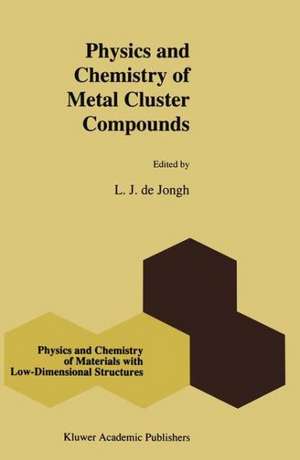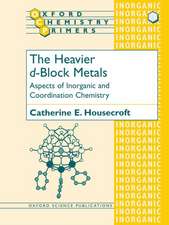Physics and Chemistry of Metal Cluster Compounds: Model Systems for Small Metal Particles: Physics and Chemistry of Materials with Low-Dimensional Structures, cartea 18
Editat de L.J. de Jonghen Limba Engleză Hardback – 31 oct 1994
| Toate formatele și edițiile | Preț | Express |
|---|---|---|
| Paperback (1) | 1041.24 lei 38-44 zile | |
| SPRINGER NETHERLANDS – 10 apr 2011 | 1041.24 lei 38-44 zile | |
| Hardback (1) | 1230.53 lei 6-8 săpt. | |
| SPRINGER NETHERLANDS – 31 oct 1994 | 1230.53 lei 6-8 săpt. |
Din seria Physics and Chemistry of Materials with Low-Dimensional Structures
- 18%
 Preț: 1830.49 lei
Preț: 1830.49 lei -
 Preț: 398.15 lei
Preț: 398.15 lei - 18%
 Preț: 1232.26 lei
Preț: 1232.26 lei - 18%
 Preț: 1223.55 lei
Preț: 1223.55 lei - 18%
 Preț: 1225.16 lei
Preț: 1225.16 lei - 18%
 Preț: 1225.31 lei
Preț: 1225.31 lei - 18%
 Preț: 1833.33 lei
Preț: 1833.33 lei - 18%
 Preț: 1228.47 lei
Preț: 1228.47 lei -
 Preț: 402.98 lei
Preț: 402.98 lei - 18%
 Preț: 1231.01 lei
Preț: 1231.01 lei -
 Preț: 386.99 lei
Preț: 386.99 lei - 18%
 Preț: 952.57 lei
Preț: 952.57 lei - 18%
 Preț: 1227.99 lei
Preț: 1227.99 lei - 18%
 Preț: 962.18 lei
Preț: 962.18 lei - 15%
 Preț: 586.37 lei
Preț: 586.37 lei - 18%
 Preț: 1229.73 lei
Preț: 1229.73 lei
Preț: 1230.53 lei
Preț vechi: 1500.64 lei
-18% Nou
Puncte Express: 1846
Preț estimativ în valută:
235.46€ • 246.50$ • 194.83£
235.46€ • 246.50$ • 194.83£
Carte tipărită la comandă
Livrare economică 07-21 aprilie
Preluare comenzi: 021 569.72.76
Specificații
ISBN-13: 9780792327158
ISBN-10: 0792327152
Pagini: 320
Ilustrații: XII, 320 p.
Dimensiuni: 155 x 235 x 27 mm
Greutate: 0.81 kg
Ediția:1994
Editura: SPRINGER NETHERLANDS
Colecția Springer
Seria Physics and Chemistry of Materials with Low-Dimensional Structures
Locul publicării:Dordrecht, Netherlands
ISBN-10: 0792327152
Pagini: 320
Ilustrații: XII, 320 p.
Dimensiuni: 155 x 235 x 27 mm
Greutate: 0.81 kg
Ediția:1994
Editura: SPRINGER NETHERLANDS
Colecția Springer
Seria Physics and Chemistry of Materials with Low-Dimensional Structures
Locul publicării:Dordrecht, Netherlands
Public țintă
ResearchCuprins
1. Introduction to Metal Cluster Compounds: From Molecule to Metal!.- 1.1. The impact of cluster-science.- 1.2. Structural characteristics of metal clusters.- 1.3. Electronic energy-level structures.- 1.4. Brief introduction to the physical properties of metal cluster compounds.- 1.5. Conductivity studies.- 1.6. Application of the Anderson-Hubbard approach.- References.- 2. High-Nuclearity Carbonyl Metal Clusters.- 2.1. Introduction.- 2.2. Synthesis and reactivity.- 2.3. Structural aspects.- 2.4. Electron counting for clusters.- References.- 3. Ligand-Stabilized Giant Metal Clusters and Colloids.- 3.1. Strategy for making giant metal clusters.- 3.2. Synthetic and structural examples.- 3.3. Chemical properties.- 3.4. Catalysis.- 3.5. Outlook.- References.- 4. Theory of Electronic Properties of Metal Clusters and Particles.- 4.1. Why are metal particles interesting?.- 4.2. Model Hamiltonians.- 4.3. Traditional quantum chemical methods.- 4.4. Density functional approaches.- 4.5. Summary.- References.- 5. X-Ray Photoelectron Spectroscopy Applied to Pure and Supported Molecular Clusters.- 5.1. Introduction.- 5.2. Generalities of photoemission spectroscopy applied to pure and supported molecular metal clusters.- 5.3. XPS of molecular clusters.- 5.4. XPS of supported molecular clusters.- 5.5. Outlook for the future.- References.- 6. Application of Mössbauer Effect Spectroscopy to Cluster Research.- 6.1. Introduction.- 6.2. Mössbauer Effect Spectroscopy (MES).- 6.3. Our Mössbauer results.- 6.4. 197Au MES on platinum clusters.- 6.5. Conclusions.- References.- 7. Specific Heat Studies on Metal Cluster Compounds.- 7.1. Introduction.- 7.2. The lattice specific heat.- 7.3. The electronic specific heat.- 7.4. Data and discussion.- 7.5. Summary.- References.- 8. NMR in SubmicronParticles.- 8.1. Introduction.- 8.2. Surface and quantum size effects.- 8.3. ESR and NMR — Theory.- 8.4. Naked clusters — Experiment and discussion.- 8.5. Aggregates of metal cluster compounds — Experiment and discussion.- 8.6. Summary.- References.- 9. Magnetic Properties and UV-Visible Spectroscopic Studies of Metal Cluster Compounds.- 9.1. Introduction.- 9.2. Magnetic properties.- 9.3. Electronic (UV-visible-NMR) spectra.- 9.4. Conclusion.- Acknowledgements.- References.- 10. Magnetic Properties of Metal Cluster Compounds.- 10.1. Introduction.- 10.2. Magnetic properties of atoms, metals and clusters.- 10.3. Experiments on metal cluster compounds.- References.- Index of Chemical Compounds.- Index of Subjects.










